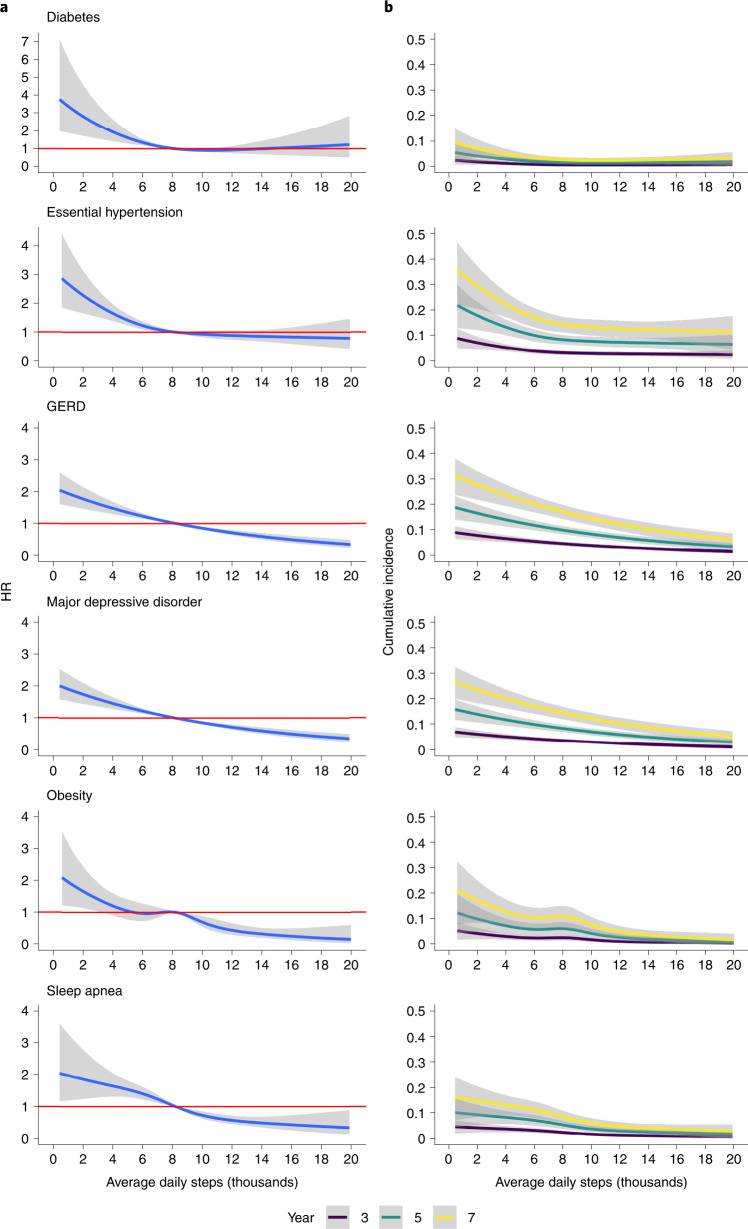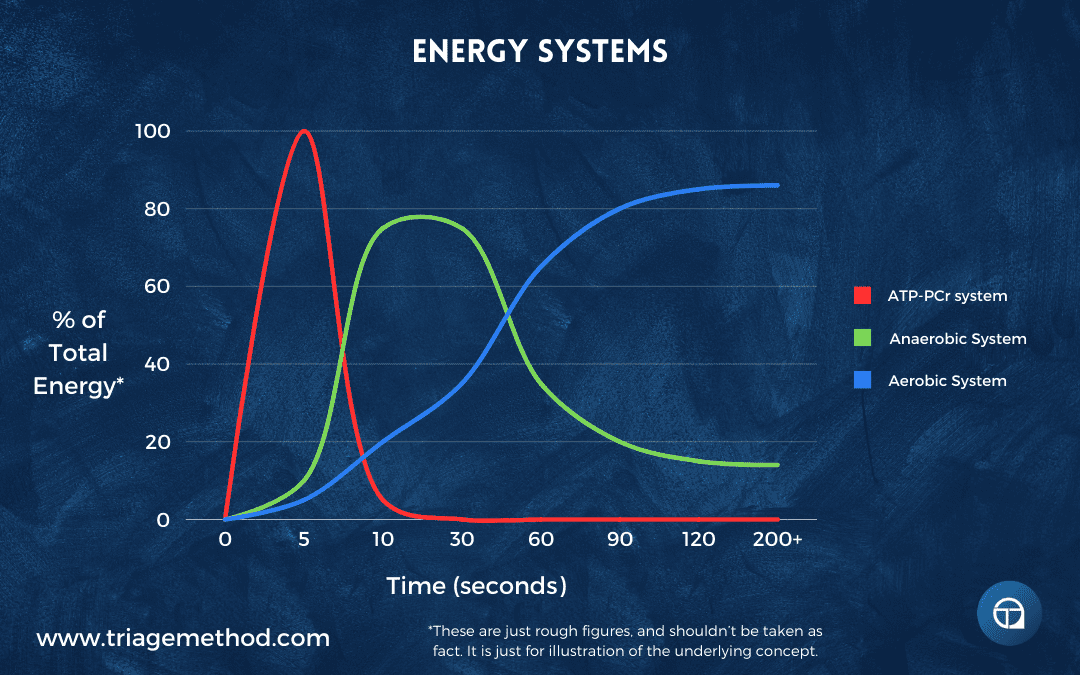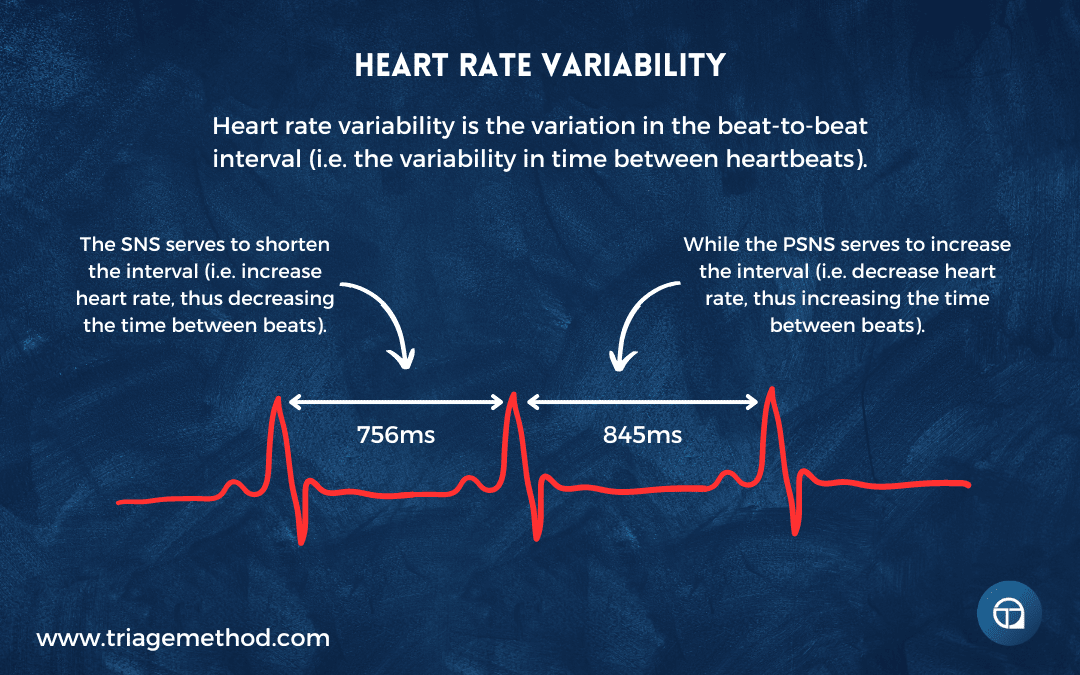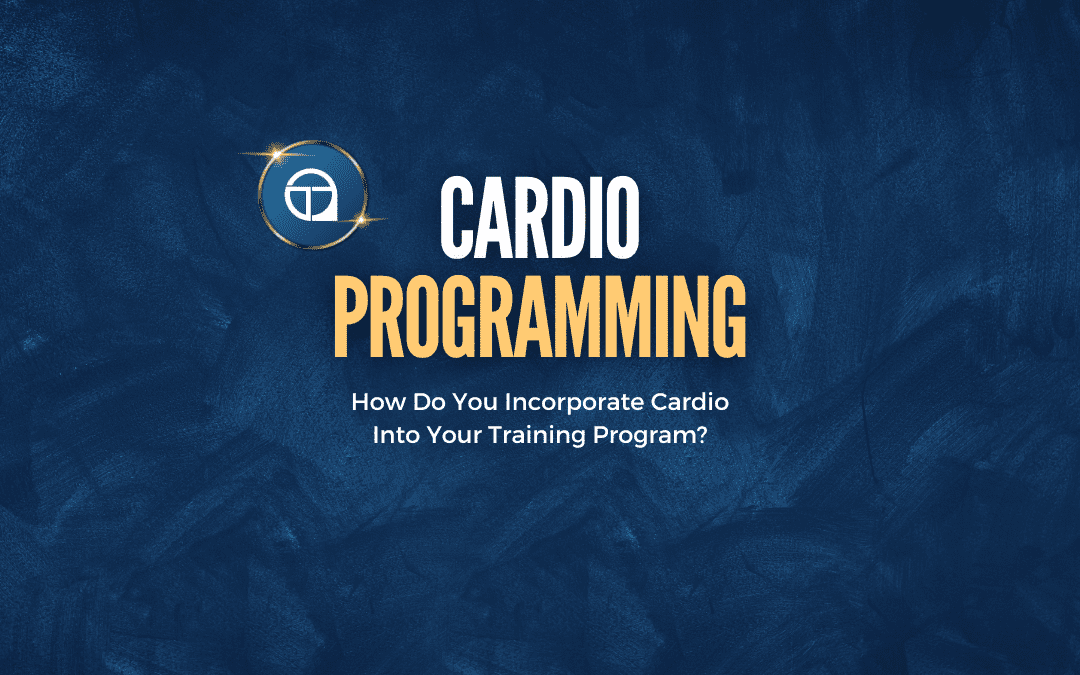Cardio programming isn’t actually too complicated or hard to understand, however, there is some nuance to it. It can be difficult for people who are new to programming cardio into their training programs, as they may simply not know where to start. Most people are introduced to cardio by virtue of sports when they were younger, and this doesn’t necessarily translate into an understanding of how to actually program cardio.
Most people simply think of cardio as “going for a run”, and very often, they just try to run as hard and/or fast as they can for this. This is not good cardio programming. Understanding a little bit more about how to think about cardio programming will allow you to design an effective cardio program that actually accomplishes your goals.
If you haven’t already, it would be incredibly helpful to also read our articles on why exercise is important, the goals of exercise, the types of exercise we have available to us, and to have a rough idea of the general exercise guidelines. It would also be very beneficial to read Why Do Cardio Training? as it helps to frame the discussion of cardio programming in this article.
You can also visit our exercise hub for more content on exercise, and you can find the resistance training article there too.
Before we get stuck in, I would just like to remind you that we offer comprehensive online coaching. So if you need help with your own exercise program or nutrition, don’t hesitate to reach out. If you are a coach (or aspiring coach) and want to learn how to coach nutrition, then consider signing up to our Nutrition Coach Certification course. We do also have an exercise program design course in the works, if you are a coach who wants to learn more about effective program design and how to coach it. We do have other courses available too.
Now, with all that out of the way, we can actually get stuck into understanding cardio programming!
Table of Contents
Understanding Cardio Programming
Informal Exercise/Daily Activity
So, we don’t want to increase our formal exercise at the expense of our daily activity level. Beyond this fact, it is generally a good idea to move more, and sit less throughout the day. Movement for health is not just about formal exercise; it is about your average activity levels day to day, week to week, month to month, and so on. This layer of the cake is one that so many forget (even very fit people).

You don’t just need to keep adding more and more steps in, you just want to standardise it to some extent.
Formal Exercise


What Type Of Cardio
When To Do Cardio
Stand-alone sessions can be quite useful when aiming for aerobic adaptations, especially at the heart level, as that usually requires 45+ minutes at that intensity to really start maximising the benefits.
Cardio Programming Conclusion
We covered a lot on cardio programming in this article, but I know we haven’t actually really covered the specific protocols you can use in your cardio programming. This article was really only intended to be an introduction to the topic of cardio programming, and there is actually quite a lot of nuance to cardio programming.
Most people have performed cardio in some manner at some point in their life, so most people are somewhat familiar with cardio. However, most people have many incorrect ideas about how to actually program cardio training. While this article hopefully cleared up a few misconceptions, it is really only as we get through the next few articles that you will really see the misconceptions about cardio programming cleared up.
As with everything, there is always more to learn, and we haven’t even begun to scratch the surface with all this stuff. However, if you are interested in staying up to date with all our content, we recommend subscribing to our newsletter and bookmarking our free content page. We do have a lot of content on how to design your own exercise program on our exercise hub.
If you would like more help with your training (or nutrition), we do also have online coaching spaces available.
We also recommend reading our foundational nutrition article, along with our foundational articles on sleep and stress management, if you really want to learn more about how to optimise your lifestyle. If you want even more free information on exercise, you can follow us on Instagram, YouTube or listen to the podcast, where we discuss all the little intricacies of exercise.
Finally, if you want to learn how to coach nutrition, then consider our Nutrition Coach Certification course. We do also have an exercise program design course in the works, if you are a coach who wants to learn more about effective program design and how to coach it. We do have other courses available too. If you don’t understand something, or you just need clarification, you can always reach out to us on Instagram or via email.
The previous article in this series is about Why Do Cardio Training? and the next article in this series is Foundational Cardio Protocols, if you are interested in continuing to learn about exercise program design. You can also go to our exercise hub to find more exercise content.
References and Further Reading
Hottenrott K, Ludyga S, Schulze S. Effects of high intensity training and continuous endurance training on aerobic capacity and body composition in recreationally active runners. J Sports Sci Med. 2012;11(3):483-488. Published 2012 Sep 1. https://www.ncbi.nlm.nih.gov/pmc/articles/PMC3737930/
Jamka M, Mądry E, Krzyżanowska-Jankowska P, et al. The effect of endurance and endurance-strength training on body composition and cardiometabolic markers in abdominally obese women: a randomised trial. Sci Rep. 2021;11(1):12339. Published 2021 Jun 11. doi:10.1038/s41598-021-90526-7 https://pubmed.ncbi.nlm.nih.gov/34117276/
Doma K, Deakin GB, Schumann M, Bentley DJ. Training Considerations for Optimising Endurance Development: An Alternate Concurrent Training Perspective. Sports Med. 2019;49(5):669-682. doi:10.1007/s40279-019-01072-2 https://pubmed.ncbi.nlm.nih.gov/30847824/
Düking P, Zinner C, Trabelsi K, et al. Monitoring and adapting endurance training on the basis of heart rate variability monitored by wearable technologies: A systematic review with meta-analysis. J Sci Med Sport. 2021;24(11):1180-1192. doi:10.1016/j.jsams.2021.04.012 https://pubmed.ncbi.nlm.nih.gov/34489178/
Milanović Z, Sporiš G, Weston M. Effectiveness of High-Intensity Interval Training (HIT) and Continuous Endurance Training for VO2max Improvements: A Systematic Review and Meta-Analysis of Controlled Trials. Sports Med. 2015;45(10):1469-1481. doi:10.1007/s40279-015-0365-0 https://pubmed.ncbi.nlm.nih.gov/26243014/
Herzig D, Asatryan B, Brugger N, Eser P, Wilhelm M. The Association Between Endurance Training and Heart Rate Variability: The Confounding Role of Heart Rate. Front Physiol. 2018;9:756. Published 2018 Jun 19. doi:10.3389/fphys.2018.00756 https://pubmed.ncbi.nlm.nih.gov/29971016/
Laursen PB, Shing CM, Peake JM, Coombes JS, Jenkins DG. Interval training program optimization in highly trained endurance cyclists. Med Sci Sports Exerc. 2002;34(11):1801-1807. doi:10.1097/00005768-200211000-00017 https://pubmed.ncbi.nlm.nih.gov/12439086/
Mrówczyński W. Health Benefits of Endurance Training: Implications of the Brain-Derived Neurotrophic Factor-A Systematic Review. Neural Plast. 2019;2019:5413067. Published 2019 Jun 24. doi:10.1155/2019/5413067 https://pubmed.ncbi.nlm.nih.gov/31341469/
Cadore EL, Pinto RS, Bottaro M, Izquierdo M. Strength and endurance training prescription in healthy and frail elderly. Aging Dis. 2014;5(3):183-195. Published 2014 Jun 1. doi:10.14336/AD.2014.0500183 https://www.ncbi.nlm.nih.gov/pmc/articles/PMC4037310/
Baquet G, van Praagh E, Berthoin S. Endurance training and aerobic fitness in young people. Sports Med. 2003;33(15):1127-1143. doi:10.2165/00007256-200333150-00004 https://pubmed.ncbi.nlm.nih.gov/14719981/
Vesterinen V, Nummela A, Heikura I, et al. Individual Endurance Training Prescription with Heart Rate Variability. Med Sci Sports Exerc. 2016;48(7):1347-1354. doi:10.1249/MSS.0000000000000910 https://pubmed.ncbi.nlm.nih.gov/26909534/
Wilson JM, Marin PJ, Rhea MR, Wilson SM, Loenneke JP, Anderson JC. Concurrent training: a meta-analysis examining interference of aerobic and resistance exercises. J Strength Cond Res. 2012;26(8):2293-2307. doi:10.1519/JSC.0b013e31823a3e2d https://pubmed.ncbi.nlm.nih.gov/22002517/
Tanaka H, Swensen T. Impact of resistance training on endurance performance. A new form of cross-training?. Sports Med. 1998;25(3):191-200. doi:10.2165/00007256-199825030-00005 https://pubmed.ncbi.nlm.nih.gov/9554029/
Foster C, Farland CV, Guidotti F, et al. The Effects of High Intensity Interval Training vs Steady State Training on Aerobic and Anaerobic Capacity. J Sports Sci Med. 2015;14(4):747-755. Published 2015 Nov 24. https://www.ncbi.nlm.nih.gov/pmc/articles/PMC4657417/
Khanfir MA, Awicha HB, Masmoudi L, et al. Effects of Different Low-Intensity Exercise Types on Duration, Energy Expenditure and Perceived Exertion in Obese Individuals. Int J Environ Res Public Health. 2022;19(8):4893. Published 2022 Apr 18. doi:10.3390/ijerph19084893 https://www.ncbi.nlm.nih.gov/pmc/articles/PMC9032643/
Bishop DJ, Botella J, Genders AJ, et al. High-Intensity Exercise and Mitochondrial Biogenesis: Current Controversies and Future Research Directions. Physiology (Bethesda). 2019;34(1):56-70. doi:10.1152/physiol.00038.2018 https://pubmed.ncbi.nlm.nih.gov/30540234/
Huertas JR, Casuso RA, Agustín PH, Cogliati S. Stay Fit, Stay Young: Mitochondria in Movement: The Role of Exercise in the New Mitochondrial Paradigm [published correction appears in Oxid Med Cell Longev. 2021 Jan 18;2021:9274841]. Oxid Med Cell Longev. 2019;2019:7058350. Published 2019 Jun 19. doi:10.1155/2019/7058350 https://www.ncbi.nlm.nih.gov/pmc/articles/PMC6607712/
Sorriento D, Di Vaia E, Iaccarino G. Physical Exercise: A Novel Tool to Protect Mitochondrial Health. Front Physiol. 2021;12:660068. Published 2021 Apr 27. doi:10.3389/fphys.2021.660068 https://pubmed.ncbi.nlm.nih.gov/33986694/
Oliveira AN, Richards BJ, Slavin M, Hood DA. Exercise Is Muscle Mitochondrial Medicine. Exerc Sport Sci Rev. 2021;49(2):67-76. doi:10.1249/JES.0000000000000250 https://pubmed.ncbi.nlm.nih.gov/33720909/
Memme JM, Erlich AT, Phukan G, Hood DA. Exercise and mitochondrial health. J Physiol. 2021;599(3):803-817. doi:10.1113/JP278853 https://pubmed.ncbi.nlm.nih.gov/31674658/
Roberts FL, Markby GR. New Insights into Molecular Mechanisms Mediating Adaptation to Exercise; A Review Focusing on Mitochondrial Biogenesis, Mitochondrial Function, Mitophagy and Autophagy. Cells. 2021;10(10):2639. Published 2021 Oct 2. doi:10.3390/cells10102639 https://www.ncbi.nlm.nih.gov/pmc/articles/PMC8533934/
Hood DA. Mechanisms of exercise-induced mitochondrial biogenesis in skeletal muscle. Appl Physiol Nutr Metab. 2009;34(3):465-472. doi:10.1139/H09-045 https://pubmed.ncbi.nlm.nih.gov/19448716/
Popov LD. Mitochondrial biogenesis: An update. J Cell Mol Med. 2020;24(9):4892-4899. doi:10.1111/jcmm.15194 https://www.ncbi.nlm.nih.gov/pmc/articles/PMC7205802/
Steiner JL, Murphy EA, McClellan JL, Carmichael MD, Davis JM. Exercise training increases mitochondrial biogenesis in the brain. J Appl Physiol (1985). 2011;111(4):1066-1071. doi:10.1152/japplphysiol.00343.2011 https://pubmed.ncbi.nlm.nih.gov/21817111/
Lee D, Son JY, Ju HM, Won JH, Park SB, Yang WH. Effects of Individualized Low-Intensity Exercise and Its Duration on Recovery Ability in Adults. Healthcare (Basel). 2021;9(3):249. Published 2021 Mar 1. doi:10.3390/healthcare9030249 https://www.ncbi.nlm.nih.gov/pmc/articles/PMC7999698/
Hua LP, Brown CA, Hains SJ, Godwin M, Parlow JL. Effects of low-intensity exercise conditioning on blood pressure, heart rate, and autonomic modulation of heart rate in men and women with hypertension. Biol Res Nurs. 2009;11(2):129-143. doi:10.1177/1099800408324853 https://pubmed.ncbi.nlm.nih.gov/19150992/
Robergs RA. A critical review of the history of low- to moderate-intensity steady-state VO2 kinetics. Sports Med. 2014;44(5):641-653. doi:10.1007/s40279-014-0161-2 https://pubmed.ncbi.nlm.nih.gov/24563157/
Steele J, Plotkin D, Van Every D, et al. Slow and Steady, or Hard and Fast? A Systematic Review and Meta-Analysis of Studies Comparing Body Composition Changes between Interval Training and Moderate Intensity Continuous Training. Sports (Basel). 2021;9(11):155. Published 2021 Nov 18. doi:10.3390/sports9110155 https://www.ncbi.nlm.nih.gov/pmc/articles/PMC8619923/
Stöggl TL, Sperlich B. The training intensity distribution among well-trained and elite endurance athletes. Front Physiol. 2015;6:295. Published 2015 Oct 27. doi:10.3389/fphys.2015.00295 https://www.ncbi.nlm.nih.gov/pmc/articles/PMC4621419/
Gaesser GA, Angadi SS. High-intensity interval training for health and fitness: can less be more?. J Appl Physiol (1985). 2011;111(6):1540-1541. doi:10.1152/japplphysiol.01237.2011 https://pubmed.ncbi.nlm.nih.gov/21979806/
Tse AC, Wong TW, Lee PH. Effect of Low-intensity Exercise on Physical and Cognitive Health in Older Adults: a Systematic Review. Sports Med Open. 2015;1(1):37. doi:10.1186/s40798-015-0034-8 https://www.ncbi.nlm.nih.gov/pmc/articles/PMC4612316/
Hackney AC, Hosick KP, Myer A, Rubin DA, Battaglini CL. Testosterone responses to intensive interval versus steady-state endurance exercise. J Endocrinol Invest. 2012;35(11):947-950. doi:10.1007/BF03346740 https://pubmed.ncbi.nlm.nih.gov/23310924/
Atakan MM, Li Y, Koşar ŞN, Turnagöl HH, Yan X. Evidence-Based Effects of High-Intensity Interval Training on Exercise Capacity and Health: A Review with Historical Perspective. Int J Environ Res Public Health. 2021;18(13):7201. Published 2021 Jul 5. doi:10.3390/ijerph18137201 https://www.ncbi.nlm.nih.gov/pmc/articles/PMC8294064/
Shepherd SO, Wilson OJ, Taylor AS, et al. Low-Volume High-Intensity Interval Training in a Gym Setting Improves Cardio-Metabolic and Psychological Health. PLoS One. 2015;10(9):e0139056. Published 2015 Sep 24. doi:10.1371/journal.pone.0139056 https://pubmed.ncbi.nlm.nih.gov/26402859/
Ito S. High-intensity interval training for health benefits and care of cardiac diseases – The key to an efficient exercise protocol. World J Cardiol. 2019;11(7):171-188. doi:10.4330/wjc.v11.i7.171 https://www.ncbi.nlm.nih.gov/pmc/articles/PMC6763680/
Wen D, Utesch T, Wu J, et al. Effects of different protocols of high intensity interval training for VO2max improvements in adults: A meta-analysis of randomised controlled trials. J Sci Med Sport. 2019;22(8):941-947. doi:10.1016/j.jsams.2019.01.013 https://pubmed.ncbi.nlm.nih.gov/30733142/
Gillen JB, Gibala MJ. Is high-intensity interval training a time-efficient exercise strategy to improve health and fitness?. Appl Physiol Nutr Metab. 2014;39(3):409-412. doi:10.1139/apnm-2013-0187 https://pubmed.ncbi.nlm.nih.gov/24552392/
Roy M, Williams SM, Brown RC, et al. High-Intensity Interval Training in the Real World: Outcomes from a 12-Month Intervention in Overweight Adults. Med Sci Sports Exerc. 2018;50(9):1818-1826. doi:10.1249/MSS.0000000000001642 https://pubmed.ncbi.nlm.nih.gov/29683919/
Vasconcelos BB, Protzen GV, Galliano LM, Kirk C, Del Vecchio FB. Effects of High-Intensity Interval Training in Combat Sports: A Systematic Review with Meta-Analysis. J Strength Cond Res. 2020;34(3):888-900. doi:10.1519/JSC.0000000000003255 https://pubmed.ncbi.nlm.nih.gov/31904713/
Karlsen T, Aamot IL, Haykowsky M, Rognmo Ø. High Intensity Interval Training for Maximizing Health Outcomes. Prog Cardiovasc Dis. 2017;60(1):67-77. doi:10.1016/j.pcad.2017.03.006 https://pubmed.ncbi.nlm.nih.gov/28385556/
Sousa AC, Neiva HP, Izquierdo M, Cadore EL, Alves AR, Marinho DA. Concurrent Training and Detraining: brief Review on the Effect of Exercise Intensities. Int J Sports Med. 2019;40(12):747-755. doi:10.1055/a-0975-9471 https://pubmed.ncbi.nlm.nih.gov/31476783/
Methenitis S. A Brief Review on Concurrent Training: From Laboratory to the Field. Sports (Basel). 2018;6(4):127. Published 2018 Oct 24. doi:10.3390/sports6040127 https://www.ncbi.nlm.nih.gov/pmc/articles/PMC6315763/
Berryman N, Mujika I, Bosquet L. Concurrent Training for Sports Performance: The 2 Sides of the Medal. Int J Sports Physiol Perform. 2019;14(3):279-285. doi:10.1123/ijspp.2018-0103 https://pubmed.ncbi.nlm.nih.gov/29809072/
Baar K. Using molecular biology to maximize concurrent training. Sports Med. 2014;44 Suppl 2(Suppl 2):S117-S125. doi:10.1007/s40279-014-0252-0 https://pubmed.ncbi.nlm.nih.gov/25355186/
Sousa AC, Neiva HP, Gil MH, et al. Concurrent Training and Detraining: The Influence of Different Aerobic Intensities. J Strength Cond Res. 2020;34(9):2565-2574. doi:10.1519/JSC.0000000000002874 https://pubmed.ncbi.nlm.nih.gov/30946274/
Gäbler M, Prieske O, Hortobágyi T, Granacher U. The Effects of Concurrent Strength and Endurance Training on Physical Fitness and Athletic Performance in Youth: A Systematic Review and Meta-Analysis. Front Physiol. 2018;9:1057. Published 2018 Aug 7. doi:10.3389/fphys.2018.01057 https://pubmed.ncbi.nlm.nih.gov/30131714/
Leveritt M, Abernethy PJ, Barry BK, Logan PA. Concurrent strength and endurance training. A review. Sports Med. 1999;28(6):413-427. doi:10.2165/00007256-199928060-00004 https://pubmed.ncbi.nlm.nih.gov/10623984/
Huiberts RO, Wüst RCI, van der Zwaard S. Concurrent Strength and Endurance Training: A Systematic Review and Meta-Analysis on the Impact of Sex and Training Status. Sports Med. 2024;54(2):485-503. doi:10.1007/s40279-023-01943-9 https://pubmed.ncbi.nlm.nih.gov/37847373/
Scribbans TD, Vecsey S, Hankinson PB, Foster WS, Gurd BJ. The Effect of Training Intensity on VO2max in Young Healthy Adults: A Meta-Regression and Meta-Analysis. Int J Exerc Sci. 2016;9(2):230-247. Published 2016 Apr 1. https://www.ncbi.nlm.nih.gov/pmc/articles/PMC4836566/
Gim MN, Choi JH. The effects of weekly exercise time on VO2max and resting metabolic rate in normal adults. J Phys Ther Sci. 2016;28(4):1359-1363. doi:10.1589/jpts.28.1359 https://www.ncbi.nlm.nih.gov/pmc/articles/PMC4868243/
Gormley SE, Swain DP, High R, et al. Effect of intensity of aerobic training on VO2max. Med Sci Sports Exerc. 2008;40(7):1336-1343. doi:10.1249/MSS.0b013e31816c4839 https://pubmed.ncbi.nlm.nih.gov/18580415/
Yang Q, Li D, Xie H, et al. Effects of sprint interval training on maximal oxygen uptake in athletes: a meta-analysis. J Sports Med Phys Fitness. Published online October 5, 2021. doi:10.23736/S0022-4707.21.12815-4 https://pubmed.ncbi.nlm.nih.gov/34609099/
Bacon AP, Carter RE, Ogle EA, Joyner MJ. VO2max trainability and high intensity interval training in humans: a meta-analysis. PLoS One. 2013;8(9):e73182. Published 2013 Sep 16. doi:10.1371/journal.pone.0073182 https://pubmed.ncbi.nlm.nih.gov/24066036/
Lundby C, Montero D, Joyner M. Biology of VO2 max: looking under the physiology lamp. Acta Physiol (Oxf). 2017;220(2):218-228. doi:10.1111/apha.12827 https://pubmed.ncbi.nlm.nih.gov/27888580/
MacInnis MJ, Gibala MJ. Physiological adaptations to interval training and the role of exercise intensity. J Physiol. 2017;595(9):2915-2930. doi:10.1113/JP273196 https://www.ncbi.nlm.nih.gov/pmc/articles/PMC5407969/
Tanaka H. Effects of cross-training. Transfer of training effects on VO2max between cycling, running and swimming. Sports Med. 1994;18(5):330-339. doi:10.2165/00007256-199418050-00005 https://pubmed.ncbi.nlm.nih.gov/7871294/
Weltman A, Snead D, Seip R, et al. Percentages of maximal heart rate, heart rate reserve and VO2max for determining endurance training intensity in male runners. Int J Sports Med. 1990;11(3):218-222. doi:10.1055/s-2007-1024795 https://pubmed.ncbi.nlm.nih.gov/2373580/
Daniels JT, Yarbrough RA, Foster C. Changes in VO2 max and running performance with training. Eur J Appl Physiol Occup Physiol. 1978;39(4):249-254. doi:10.1007/BF00421448 https://pubmed.ncbi.nlm.nih.gov/710390/
Dolgener FA, Brooks WB. The effects of interval and continuous training on VO2 max and performance in the mile run. J Sports Med Phys Fitness. 1978;18(4):345-352. https://pubmed.ncbi.nlm.nih.gov/745381/
Seiler KS, Kjerland GØ. Quantifying training intensity distribution in elite endurance athletes: is there evidence for an “optimal” distribution?. Scand J Med Sci Sports. 2006;16(1):49-56. doi:10.1111/j.1600-0838.2004.00418.x https://pubmed.ncbi.nlm.nih.gov/16430681/
Pate RR, Durstine JL. Exercise physiology and its role in clinical sports medicine. South Med J. 2004;97(9):881-885. doi:10.1097/01.SMJ.0000140116.17258.F1 https://pubmed.ncbi.nlm.nih.gov/15455979/
Rivera-Brown AM, Frontera WR. Principles of exercise physiology: responses to acute exercise and long-term adaptations to training. PM R. 2012;4(11):797-804. doi:10.1016/j.pmrj.2012.10.007 https://pubmed.ncbi.nlm.nih.gov/23174541/
Kiens B, Richter EA, Wojtaszewski JF. Exercise physiology: from performance studies to muscle physiology and cardiovascular adaptations. J Appl Physiol (1985). 2014;117(9):943-944. doi:10.1152/japplphysiol.00874.2014 https://pubmed.ncbi.nlm.nih.gov/25277739/
Ferretti G, Fagoni N, Taboni A, Vinetti G, di Prampero PE. A century of exercise physiology: key concepts on coupling respiratory oxygen flow to muscle energy demand during exercise. Eur J Appl Physiol. 2022;122(6):1317-1365. doi:10.1007/s00421-022-04901-x https://pubmed.ncbi.nlm.nih.gov/35217911/
Pedersen BK. The Physiology of Optimizing Health with a Focus on Exercise as Medicine. Annu Rev Physiol. 2019;81:607-627. doi:10.1146/annurev-physiol-020518-114339 https://pubmed.ncbi.nlm.nih.gov/30526319/
Powers SK, Hogan MC. Advances in exercise physiology: exercise and health. J Physiol. 2021;599(3):769-770. doi:10.1113/JP281003 https://pubmed.ncbi.nlm.nih.gov/33521984/
Irvin CG. Exercise physiology. Allergy Asthma Proc. 1996;17(6):327-330. doi:10.2500/108854196778606356 https://pubmed.ncbi.nlm.nih.gov/8993725/
Helgerud J, Høydal K, Wang E, et al. Aerobic high-intensity intervals improve VO2max more than moderate training. Med Sci Sports Exerc. 2007;39(4):665-671. doi:10.1249/mss.0b013e3180304570 https://pubmed.ncbi.nlm.nih.gov/17414804/
Acevedo EO, Goldfarb AH. Increased training intensity effects on plasma lactate, ventilatory threshold, and endurance. Med Sci Sports Exerc. 1989;21(5):563-568. https://pubmed.ncbi.nlm.nih.gov/2607946/
McConell GK, Costill DL, Widrick JJ, Hickey MS, Tanaka H, Gastin PB. Reduced training volume and intensity maintain aerobic capacity but not performance in distance runners. Int J Sports Med. 1993;14(1):33-37. doi:10.1055/s-2007-1021142 https://pubmed.ncbi.nlm.nih.gov/8440543/
Belman MJ, Gaesser GA. Exercise training below and above the lactate threshold in the elderly. Med Sci Sports Exerc. 1991;23(5):562-568. https://pubmed.ncbi.nlm.nih.gov/2072834/
Ito G, Feeley M, Sawai T, et al. High-intensity interval training improves respiratory and cardiovascular adjustments before and after initiation of exercise. Front Physiol. 2024;15:1227316. Published 2024 Mar 11. doi:10.3389/fphys.2024.1227316 https://pubmed.ncbi.nlm.nih.gov/38529482/
Mølmen KS, Øfsteng SJ, Rønnestad BR. Block periodization of endurance training – a systematic review and meta-analysis. Open Access J Sports Med. 2019;10:145-160. Published 2019 Oct 17. doi:10.2147/OAJSM.S180408 https://www.ncbi.nlm.nih.gov/pmc/articles/PMC6802561/
Meyer T, Auracher M, Heeg K, Urhausen A, Kindermann W. Effectiveness of low-intensity endurance training. Int J Sports Med. 2007;28(1):33-39. doi:10.1055/s-2006-924037 https://pubmed.ncbi.nlm.nih.gov/17213964/
Ferretti G, Fagoni N, Taboni A, Bruseghini P, Vinetti G. The physiology of submaximal exercise: The steady state concept. Respir Physiol Neurobiol. 2017;246:76-85. doi:10.1016/j.resp.2017.08.005 https://pubmed.ncbi.nlm.nih.gov/28818484/
Neufeld EV, Wadowski J, Boland DM, Dolezal BA, Cooper CB. Heart Rate Acquisition and Threshold-Based Training Increases Oxygen Uptake at Metabolic Threshold in Triathletes: A Pilot Study. Int J Exerc Sci. 2019;12(2):144-154. Published 2019 Jan 1. https://www.ncbi.nlm.nih.gov/pmc/articles/PMC6355121/
Zhu Z, Li H, Xiao J, Xu W, Huang MC. A fitness training optimization system based on heart rate prediction under different activities. Methods. 2022;205:89-96. doi:10.1016/j.ymeth.2022.06.006 https://pubmed.ncbi.nlm.nih.gov/35750282/
Lim AY, Chen YC, Hsu CC, Fu TC, Wang JS. The Effects of Exercise Training on Mitochondrial Function in Cardiovascular Diseases: A Systematic Review and Meta-Analysis. Int J Mol Sci. 2022;23(20):12559. Published 2022 Oct 19. doi:10.3390/ijms232012559 https://www.ncbi.nlm.nih.gov/pmc/articles/PMC9603958/
Shiraev T, Barclay G. Evidence based exercise – clinical benefits of high intensity interval training. Aust Fam Physician. 2012;41(12):960-962. https://pubmed.ncbi.nlm.nih.gov/23210120/
Laursen PB, Jenkins DG. The scientific basis for high-intensity interval training: optimising training programmes and maximising performance in highly trained endurance athletes. Sports Med. 2002;32(1):53-73. doi:10.2165/00007256-200232010-00003 https://pubmed.ncbi.nlm.nih.gov/11772161/
Kubukeli ZN, Noakes TD, Dennis SC. Training techniques to improve endurance exercise performances. Sports Med. 2002;32(8):489-509. doi:10.2165/00007256-200232080-00002 https://pubmed.ncbi.nlm.nih.gov/12076176/
Laursen PB, Shing CM, Peake JM, Coombes JS, Jenkins DG. Influence of high-intensity interval training on adaptations in well-trained cyclists. J Strength Cond Res. 2005;19(3):527-533. doi:10.1519/15964.1 https://pubmed.ncbi.nlm.nih.gov/16095414/
Esfarjani F, Laursen PB. Manipulating high-intensity interval training: effects on VO2max, the lactate threshold and 3000 m running performance in moderately trained males. J Sci Med Sport. 2007;10(1):27-35. doi:10.1016/j.jsams.2006.05.014 https://pubmed.ncbi.nlm.nih.gov/16876479/
Normand-Gravier T, Britto F, Launay T, Renfree A, Toussaint JF, Desgorces FD. Exercise Dose Equalization in High-Intensity Interval Training: A Scoping Review. Int J Environ Res Public Health. 2022;19(9):4980. Published 2022 Apr 20. doi:10.3390/ijerph19094980 https://www.ncbi.nlm.nih.gov/pmc/articles/PMC9104727/
Carey DG. Quantifying differences in the “fat burning” zone and the aerobic zone: implications for training. J Strength Cond Res. 2009;23(7):2090-2095. doi:10.1519/JSC.0b013e3181bac5c5 https://pubmed.ncbi.nlm.nih.gov/19855335/
Huang G, Wang R, Chen P, Huang SC, Donnelly JE, Mehlferber JP. Dose-response relationship of cardiorespiratory fitness adaptation to controlled endurance training in sedentary older adults. Eur J Prev Cardiol. 2016;23(5):518-529. doi:10.1177/2047487315582322 https://pubmed.ncbi.nlm.nih.gov/25901000/
Huang G, Gibson CA, Tran ZV, Osness WH. Controlled endurance exercise training and VO2max changes in older adults: a meta-analysis. Prev Cardiol. 2005;8(4):217-225. doi:10.1111/j.0197-3118.2005.04324.x https://pubmed.ncbi.nlm.nih.gov/16230876/
Katzel LI, Sorkin JD, Fleg JL. A comparison of longitudinal changes in aerobic fitness in older endurance athletes and sedentary men. J Am Geriatr Soc. 2001;49(12):1657-1664. doi:10.1046/j.1532-5415.2001.t01-1-49276.x https://pubmed.ncbi.nlm.nih.gov/11844000/
Rogers MA, Hagberg JM, Martin WH 3rd, Ehsani AA, Holloszy JO. Decline in VO2max with aging in master athletes and sedentary men. J Appl Physiol (1985). 1990;68(5):2195-2199. doi:10.1152/jappl.1990.68.5.2195 https://pubmed.ncbi.nlm.nih.gov/2361923/
Vajda M, Oreská Ľ, Černáčková A, et al. Aging and Possible Benefits or Negatives of Lifelong Endurance Running: How Master Male Athletes Differ from Young Athletes and Elderly Sedentary?. Int J Environ Res Public Health. 2022;19(20):13184. Published 2022 Oct 13. doi:10.3390/ijerph192013184 https://pubmed.ncbi.nlm.nih.gov/36293774/
Montero D, Díaz-Cañestro C. Endurance training and maximal oxygen consumption with ageing: Role of maximal cardiac output and oxygen extraction. Eur J Prev Cardiol. 2016;23(7):733-743. doi:10.1177/2047487315617118 https://pubmed.ncbi.nlm.nih.gov/26553969/
Montero D, Diaz-Cañestro C, Lundby C. Endurance Training and V˙O2max: Role of Maximal Cardiac Output and Oxygen Extraction. Med Sci Sports Exerc. 2015;47(10):2024-2033. doi:10.1249/MSS.0000000000000640 https://pubmed.ncbi.nlm.nih.gov/25680086/
Tanisho K, Hirakawa K. Training effects on endurance capacity in maximal intermittent exercise: comparison between continuous and interval training. J Strength Cond Res. 2009;23(8):2405-2410. doi:10.1519/JSC.0b013e3181bac790 https://pubmed.ncbi.nlm.nih.gov/19826281/
Ziemann E, Grzywacz T, Łuszczyk M, Laskowski R, Olek RA, Gibson AL. Aerobic and anaerobic changes with high-intensity interval training in active college-aged men. J Strength Cond Res. 2011;25(4):1104-1112. doi:10.1519/JSC.0b013e3181d09ec9 https://pubmed.ncbi.nlm.nih.gov/20661160/
Wang C, Xu Y, Zhang L, et al. Comparative efficacy of different exercise methods to improve cardiopulmonary function in stroke patients: a network meta-analysis of randomized controlled trials. Front Neurol. 2024;15:1288032. Published 2024 Jan 17. doi:10.3389/fneur.2024.1288032 https://pubmed.ncbi.nlm.nih.gov/38313560/
Mikkonen RS, Ihalainen JK, Hackney AC, Häkkinen K. Perspectives on Concurrent Strength and Endurance Training in Healthy Adult Females: A Systematic Review. Sports Med. 2024;54(3):673-696. doi:10.1007/s40279-023-01955-5 https://pubmed.ncbi.nlm.nih.gov/37948036/
Markov A, Hauser L, Chaabene H. Effects of Concurrent Strength and Endurance Training on Measures of Physical Fitness in Healthy Middle-Aged and Older Adults: A Systematic Review with Meta-Analysis. Sports Med. 2023;53(2):437-455. doi:10.1007/s40279-022-01764-2 https://pubmed.ncbi.nlm.nih.gov/36222981/
Heyne E, Zeeb S, Junker C, et al. Exercise Training Differentially Affects Skeletal Muscle Mitochondria in Rats with Inherited High or Low Exercise Capacity. Cells. 2024;13(5):393. Published 2024 Feb 24. doi:10.3390/cells13050393 https://pubmed.ncbi.nlm.nih.gov/38474357/
Nikolaidis PT, Knechtle B. Predictors of half-marathon performance in male recreational athletes. EXCLI J. 2023;22:559-566. Published 2023 Jun 22. doi:10.17179/excli2023-6198 https://pubmed.ncbi.nlm.nih.gov/37534223/
Daussin FN, Ponsot E, Dufour SP, et al. Improvement of VO2max by cardiac output and oxygen extraction adaptation during intermittent versus continuous endurance training. Eur J Appl Physiol. 2007;101(3):377-383. doi:10.1007/s00421-007-0499-3 https://pubmed.ncbi.nlm.nih.gov/17661072/
Sperlich B, Matzka M, Holmberg HC. The proportional distribution of training by elite endurance athletes at different intensities during different phases of the season. Front Sports Act Living. 2023;5:1258585. Published 2023 Oct 27. doi:10.3389/fspor.2023.1258585 https://pubmed.ncbi.nlm.nih.gov/37964776/
Cao M, Quan M, Zhuang J. Effect of High-Intensity Interval Training versus Moderate-Intensity Continuous Training on Cardiorespiratory Fitness in Children and Adolescents: A Meta-Analysis. Int J Environ Res Public Health. 2019;16(9):1533. Published 2019 Apr 30. doi:10.3390/ijerph16091533 https://pubmed.ncbi.nlm.nih.gov/31052205/
Monserdà-Vilaró A, Balsalobre-Fernández C, Hoffman JR, Alix-Fages C, Jiménez SL. Effects of Concurrent Resistance and Endurance Training Using Continuous or Intermittent Protocols on Muscle Hypertrophy: Systematic Review With Meta-Analysis. J Strength Cond Res. 2023;37(3):688-709. doi:10.1519/JSC.0000000000004304 https://pubmed.ncbi.nlm.nih.gov/36508686/
Burgomaster KA, Howarth KR, Phillips SM, et al. Similar metabolic adaptations during exercise after low volume sprint interval and traditional endurance training in humans. J Physiol. 2008;586(1):151-160. doi:10.1113/jphysiol.2007.142109 https://pubmed.ncbi.nlm.nih.gov/17991697/
Hawley JA. Specificity of training adaptation: time for a rethink?. J Physiol. 2008;586(1):1-2. doi:10.1113/jphysiol.2007.147397 https://pubmed.ncbi.nlm.nih.gov/18167367/
Gibala MJ, Little JP, van Essen M, et al. Short-term sprint interval versus traditional endurance training: similar initial adaptations in human skeletal muscle and exercise performance. J Physiol. 2006;575(Pt 3):901-911. doi:10.1113/jphysiol.2006.112094 https://pubmed.ncbi.nlm.nih.gov/16825308/
Gibala MJ, Jones AM. Physiological and performance adaptations to high-intensity interval training. Nestle Nutr Inst Workshop Ser. 2013;76:51-60. doi:10.1159/000350256 https://pubmed.ncbi.nlm.nih.gov/23899754/
Ekkekakis P, Swinton P, Tiller NB. Extraordinary Claims in the Literature on High-Intensity Interval Training (HIIT): I. Bonafide Scientific Revolution or a Looming Crisis of Replication and Credibility?. Sports Med. 2023;53(10):1865-1890. doi:10.1007/s40279-023-01880-7 https://pubmed.ncbi.nlm.nih.gov/37561389/
Ekkekakis P, Vallance J, Wilson PM, Ewing Garber C. Extraordinary claims in the literature on high-intensity interval training (HIIT): III. Critical analysis of four foundational arguments from an interdisciplinary lens. Psychol Sport Exerc. 2023;66:102399. doi:10.1016/j.psychsport.2023.102399 https://pubmed.ncbi.nlm.nih.gov/37665861/
Ekkekakis P, Biddle SJH. Extraordinary claims in the literature on high-intensity interval training (HIIT): IV. Is HIIT associated with higher long-term exercise adherence?. Psychol Sport Exerc. 2023;64:102295. doi:10.1016/j.psychsport.2022.102295 https://pubmed.ncbi.nlm.nih.gov/37665824/
Coates AM, Joyner MJ, Little JP, Jones AM, Gibala MJ. A Perspective on High-Intensity Interval Training for Performance and Health. Sports Med. 2023;53(Suppl 1):85-96. doi:10.1007/s40279-023-01938-6 https://pubmed.ncbi.nlm.nih.gov/37804419/
Cochran AJ, Percival ME, Tricarico S, et al. Intermittent and continuous high-intensity exercise training induce similar acute but different chronic muscle adaptations. Exp Physiol. 2014;99(5):782-791. doi:10.1113/expphysiol.2013.077453 https://pubmed.ncbi.nlm.nih.gov/24532598/
Laursen PB. Training for intense exercise performance: high-intensity or high-volume training?. Scand J Med Sci Sports. 2010;20 Suppl 2:1-10. doi:10.1111/j.1600-0838.2010.01184.x https://pubmed.ncbi.nlm.nih.gov/20840557/
Ross A, Leveritt M. Long-term metabolic and skeletal muscle adaptations to short-sprint training: implications for sprint training and tapering. Sports Med. 2001;31(15):1063-1082. doi:10.2165/00007256-200131150-00003 https://pubmed.ncbi.nlm.nih.gov/11735686/
Soylu Y, Krustrup P, Mohr M, Arslan E, Kilit B, Radzimiński Ł. Effects of Two Different Self-Paced Training Modalities on the Aerobic Fitness Levels, Psychophysiological Responses, and Antioxidant Status in Physically Active Young Adults. J Clin Med. 2023;12(23):7232. Published 2023 Nov 22. doi:10.3390/jcm12237232 https://pubmed.ncbi.nlm.nih.gov/38068283/
Little JP, Safdar A, Wilkin GP, Tarnopolsky MA, Gibala MJ. A practical model of low-volume high-intensity interval training induces mitochondrial biogenesis in human skeletal muscle: potential mechanisms. J Physiol. 2010;588(Pt 6):1011-1022. doi:10.1113/jphysiol.2009.181743 https://pubmed.ncbi.nlm.nih.gov/20100740/
Hood MS, Little JP, Tarnopolsky MA, Myslik F, Gibala MJ. Low-volume interval training improves muscle oxidative capacity in sedentary adults. Med Sci Sports Exerc. 2011;43(10):1849-1856. doi:10.1249/MSS.0b013e3182199834 https://pubmed.ncbi.nlm.nih.gov/21448086/
Gibala MJ, McGee SL. Metabolic adaptations to short-term high-intensity interval training: a little pain for a lot of gain?. Exerc Sport Sci Rev. 2008;36(2):58-63. doi:10.1097/JES.0b013e318168ec1f https://pubmed.ncbi.nlm.nih.gov/18362686/
Astorino TA, Schubert MM, Palumbo E, et al. Magnitude and time course of changes in maximal oxygen uptake in response to distinct regimens of chronic interval training in sedentary women. Eur J Appl Physiol. 2013;113(9):2361-2369. doi:10.1007/s00421-013-2672-1 https://pubmed.ncbi.nlm.nih.gov/23754097/
Hickson RC, Bomze HA, Holloszy JO. Linear increase in aerobic power induced by a strenuous program of endurance exercise. J Appl Physiol Respir Environ Exerc Physiol. 1977;42(3):372-376. doi:10.1152/jappl.1977.42.3.372 https://pubmed.ncbi.nlm.nih.gov/838658/
Habibi E, Dehghan H, Moghiseh M, Hasanzadeh A. Study of the relationship between the aerobic capacity (VO2 max) and the rating of perceived exertion based on the measurement of heart beat in the metal industries Esfahan. J Educ Health Promot. 2014;3:55. Published 2014 Jun 23. doi:10.4103/2277-9531.134751 https://pubmed.ncbi.nlm.nih.gov/25077148/
Losnegard T, Skarli S, Hansen J, et al. Is Rating of Perceived Exertion a Valuable Tool for Monitoring Exercise Intensity During Steady-State Conditions in Elite Endurance Athletes?. Int J Sports Physiol Perform. 2021;16(11):1589-1595. doi:10.1123/ijspp.2020-0866 https://pubmed.ncbi.nlm.nih.gov/33831841/
Zamunér AR, Moreno MA, Camargo TM, et al. Assessment of Subjective Perceived Exertion at the Anaerobic Threshold with the Borg CR-10 Scale. J Sports Sci Med. 2011;10(1):130-136. Published 2011 Mar 1. https://pubmed.ncbi.nlm.nih.gov/24149305/
Cunha FA, Midgley AW, Monteiro WD, Campos FK, Farinatti PT. The relationship between oxygen uptake reserve and heart rate reserve is affected by intensity and duration during aerobic exercise at constant work rate. Appl Physiol Nutr Metab. 2011;36(6):839-847. doi:10.1139/h11-100 https://pubmed.ncbi.nlm.nih.gov/22034854/
Hwang J, Moon NR, Heine O, Yang WH. The ability of energy recovery in professional soccer players is increased by individualized low-intensity exercise. PLoS One. 2022;17(6):e0270484. Published 2022 Jun 30. doi:10.1371/journal.pone.0270484 https://pubmed.ncbi.nlm.nih.gov/35771850/
Stanley J, Peake JM, Buchheit M. Cardiac parasympathetic reactivation following exercise: implications for training prescription. Sports Med. 2013;43(12):1259-1277. doi:10.1007/s40279-013-0083-4 https://pubmed.ncbi.nlm.nih.gov/23912805/
Buchheit M, Simon C, Piquard F, Ehrhart J, Brandenberger G. Effects of increased training load on vagal-related indexes of heart rate variability: a novel sleep approach. Am J Physiol Heart Circ Physiol. 2004;287(6):H2813-H2818. doi:10.1152/ajpheart.00490.2004 https://pubmed.ncbi.nlm.nih.gov/15308479/
Iwasaki K, Zhang R, Zuckerman JH, Levine BD. Dose-response relationship of the cardiovascular adaptation to endurance training in healthy adults: how much training for what benefit?. J Appl Physiol (1985). 2003;95(4):1575-1583. doi:10.1152/japplphysiol.00482.2003 https://pubmed.ncbi.nlm.nih.gov/12832429/
Weeks KL, McMullen JR. The athlete’s heart vs. the failing heart: can signaling explain the two distinct outcomes?. Physiology (Bethesda). 2011;26(2):97-105. doi:10.1152/physiol.00043.2010 https://pubmed.ncbi.nlm.nih.gov/21487028/
Tomlin DL, Wenger HA. The relationship between aerobic fitness and recovery from high intensity intermittent exercise. Sports Med. 2001;31(1):1-11. doi:10.2165/00007256-200131010-00001 https://pubmed.ncbi.nlm.nih.gov/11219498/
Børsheim E, Bahr R. Effect of exercise intensity, duration and mode on post-exercise oxygen consumption. Sports Med. 2003;33(14):1037-1060. doi:10.2165/00007256-200333140-00002 https://pubmed.ncbi.nlm.nih.gov/14599232/
Jones AM, Carter H. The effect of endurance training on parameters of aerobic fitness. Sports Med. 2000;29(6):373-386. doi:10.2165/00007256-200029060-00001 https://pubmed.ncbi.nlm.nih.gov/10870864/
Bell GJ, Snydmiller GD, Davies DS, Quinney HA. Relationship between aerobic fitness and metabolic recovery from intermittent exercise in endurance athletes . Can J Appl Physiol. 1997;22(1):78-85. doi:10.1139/h97-008 https://pubmed.ncbi.nlm.nih.gov/9018410/
Sloth M, Sloth D, Overgaard K, Dalgas U. Effects of sprint interval training on VO2max and aerobic exercise performance: A systematic review and meta-analysis. Scand J Med Sci Sports. 2013;23(6):e341-e352. doi:10.1111/sms.12092 https://pubmed.ncbi.nlm.nih.gov/23889316/
Lundberg TR, Larsson G, Alstermark R, Mandić M, Fernandez-Gonzalo R. Relationship between maximal oxygen uptake, within-set fatigue and between-set recovery during resistance exercise in resistance-trained men and women. BMC Sports Sci Med Rehabil. 2024;16(1):45. Published 2024 Feb 12. doi:10.1186/s13102-024-00830-8 https://pubmed.ncbi.nlm.nih.gov/38347629/
Saw AE, Main LC, Gastin PB. Monitoring the athlete training response: subjective self-reported measures trump commonly used objective measures: a systematic review. Br J Sports Med. 2016;50(5):281-291. doi:10.1136/bjsports-2015-094758 https://www.ncbi.nlm.nih.gov/pmc/articles/PMC4789708/
Muñoz I, Seiler S, Bautista J, España J, Larumbe E, Esteve-Lanao J. Does polarized training improve performance in recreational runners?. Int J Sports Physiol Perform. 2014;9(2):265-272. doi:10.1123/ijspp.2012-0350 https://pubmed.ncbi.nlm.nih.gov/23752040/

